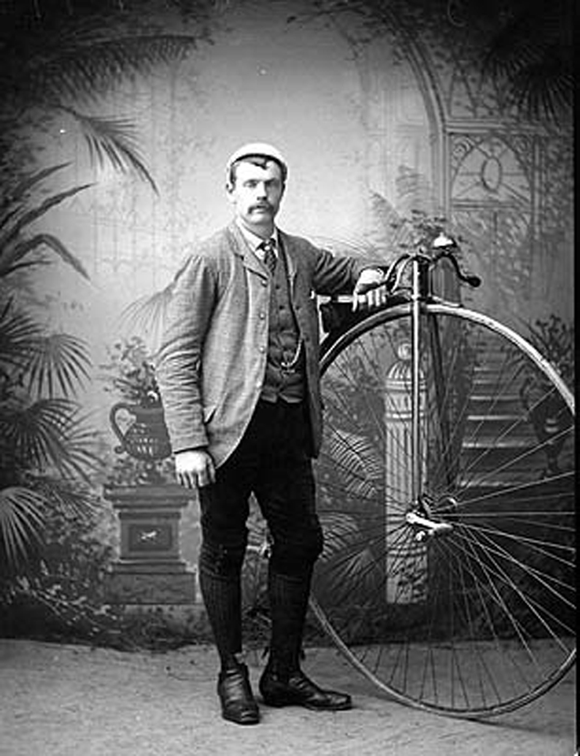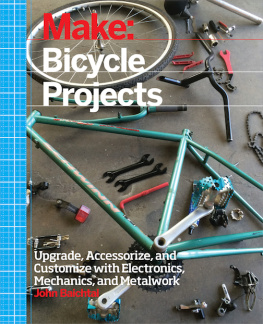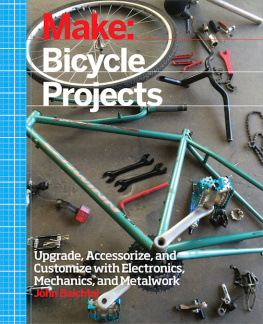Make: Bicycle Projects
by John Baichtal
Copyright 2015 John Baichtal. All rights reserved.
Printed in Canada.
Published by Maker Media, Inc., 1160 Battery Street East, Suite 125, San Francisco, CA 94111.
Maker Media books may be purchased for educational, business, or sales promotional use. Online editions are also available for most titles (http://safaribooksonline.com). For more information, contact our corporate/institutional sales department: 800-998-9938 or corporate@oreilly.com .
- Editor: Patrick Di Justo
- Production Editor: Melanie Yarbrough
- Copyeditor: Jasmine Kwityn
- Proofreader: Charles Roumeliotis
- Indexer: WordCo Indexing Services
- Interior Designer: David Futato
- Cover Designer: Karen Montgomery
- Illustrator: Rebecca Demarest
- August 2015: First Edition
Revision History for the First Edition
- 2015-08-05: First Release
See http://oreilly.com/catalog/errata.csp?isbn=9781457186431 for release details.
The Make logo is a registered trademark of Maker Media, Inc. Make: Bicycle Projects, the cover image, and related trade dress are trademarks of Maker Media, Inc.
While the publisher and the author have used good faith efforts to ensure that the information and instructions contained in this work are accurate, the publisher and the author disclaim all responsibility for errors or omissions, including without limitation responsibility for damages resulting from the use of or reliance on this work. Use of the information and instructions contained in this work is at your own risk. If any code samples or other technology this work contains or describes is subject to open source licenses or the intellectual property rights of others, it is your responsibility to ensure that your use thereof complies with such licenses and/or rights.
978-1-457-18643-1
[TI]
Preface
Nearly everything we own cant be modified, or requires the help of an expert. Some gearheads can fix their own cars but most of us cant. Techies can open up a computer and add or replace components, but many users are afraid to. What if you messed it up?
Bicycles are one of the few devices we own that not only are user modifiable, but most riders already have done so, if only by adding more air to the tires or adjusting the seat and handlebars. All but the least tool-savvy rider can easily add a beverage holder or horn, and kids apply stickers and other decorations all the time.
Perhaps price is a factor. You can get a decent used bike for $50 that will last you for years, but a similarly priced computer will be e-waste within a few months. If you were to wreck your bike trying to modify it, well, its not like it was a $10,000 car. This lowers the fear factor and encourages adventuresome modifications.
That said, its not all easy. Over the decades bike builders have settled on a rather complicated set of tools to loosen each part, and performing major mods necessitates having access to these tools. There is a learning curve as well, forcing you to research how to assemble gear cassettes and reconfigure chains.
And thats just the mechanical aspect. Makers have access to any number of resources for customizing their rides and making them work better. Electronics comes to mindmany bike riders have learned how to add sensors, microcontrollers, and other electronics to their bicycles.
A tiny subset practices the most radical of modifications: frankensteining two bikes together to form a new one, welding the tubes together themselves. Even more radically, some people simply weld up their own frames from steel tubing, to make it more truly their own.
I wrote Make: Bicycle Projects to encourage readers to make any and all of those modifications. If all youre comfortable with is creating your own bike basket or tightening a spoke, I got you covered. If youre ready to get crazy, Im there for you as well. Good biking and good hacking!
Chapter 1. Bike 101
Bicycles are big. Most of us grew up with them and learned to ride aschildren. There are an estimated 1 billion bikes on the planet.
A good chunk of that billion seems to reside in my garage.
Thats kind of the joke about bikes, right? You always seem to collectold and busted ones, which end up clogging your storage space until they get donated, sold, or thrown out en masse. ) than it is to get that bikes wheel repaired in a bike shop. Betweenthe cost of labor and parts, why not just buy new? On the other end ofthe spectrum, there are the hipster cruisers often selling for upwardsof $1,000 apiece. These are not bikes you would hesitate tofix.

Figure 1-1. This kiddie bike is crying out to be hacked!
There is a beautiful middle ground between buying cheap junk not worthrepairing, and buying expensive hardware you can barely afford. Thesolution is to make and modify your own bicycle. This book shows youhow, ranging from welding up a frame to converting your regular bike into a cargo bike capable of hauling a couple bags of groceries. Along the way, youll explore electronics, build a bike horn, add LED effects, and complete a bunch more projects to make your bike uniquely yours.
Bikes are everywhere. Find one and make it your own.
Origins
The bicycle was developed over time by many different inventors and mechanics across the world, with each person contributing a few new ideas to what became a very cool invention. The original two-wheeled, human-powered bike was the Dandy Horse, introduced in Mannheim in 1817 and Paris in 1818. It resembled a bike without pedals, chains, or gears, and it was propelled, Fred Flintstone-like, by the riders feet running along the ground. It took several false starts before bike makers settled on the now-classic configuration.
While just a fad, the Penny Farthing became a symbol of the Victorian era, and its technology lives on: bike makers attempts to find the perfect wheel ratios led to the adoption of the chain drive as the go-to method of propulsion, and those ratios still exist today.
The creation of the chain drive, and its adoption by bicycle manufacturers, had in effect created a recognized standard bicycle: two wheels of identical size, with a metal frame connecting the wheels, and a sprocket equipped with pedals positioned between them. The cyclist sits on a saddle attached to the frame, and his or her pedaling energy is transmitted to the rear wheel with the help of a chain drive.
About the same time that this standard settled into place, around the end of the 19th century, a full-fledged bike craze began sweeping the world.

Figure 1-2. The Penny Farthing was a popular configuration of bicycle in the late 1800s
Anatomy of a Bicycle
Taking those configurations into consideration, a bicycle still boilsdown to a basic set of components: two wheels (usually), a frame toconnect them, a place to sit, a braking system, and a set of pedalsconnected to an axle with a chain to drive the whole thing. Lets now review the various parts of the classic bike.
Brakes
. Another type is the coaster brake,the classic feature of kids bikes. Well-heeled bike riders also dabblein disc brakes, which work by grabbing a disc mounted parallel to thewheel, rather than grabbing the wheel itself. Some cyclists remove thebrakes altogether, preferring to rely on their biking skills to slowdown in a hurry.













